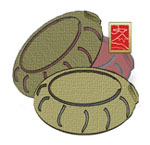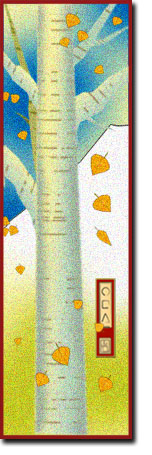On The Way: The Daily Zen Journal
Platform Sutra pt 2
Hui-neng
I have come here today because I have a connection of many lifetimes with you officials, clerics, and laypeople. This teaching has been passed down by the ancients. It isn’t something I discovered by myself. But if you wish to hear this teaching of the ancients, you must listen with pure minds. And if you wish to get rid of your delusions, you should understand it as past generations have.
Good friends! You already possess the prajna wisdom of enlightenment!
But because your minds are deluded, you can’t understand by yourselves. You need to find a truly good friend to show you the way to see your nature. Good friends, buddha nature isn’t different for the ignorant and the wise. It’s just that people are deluded or awake. When people are deluded, they’re ignorant. When they wake up, they become wise.
Good friends, this Dharma teaching of mine is based on meditation and wisdom. But don’t make the mistake of thinking that meditation and wisdom are separate. Meditation and wisdom are of one essence and not two. Meditation is the body of wisdom, and wisdom is the function of meditation. Wherever you find wisdom, you find meditation. And wherever you find meditation, you find wisdom. Good friends, what this means is that meditation and wisdom are the same.
Fellow students of the Way, be careful. Don’t think that meditation comes first and then gives rise to wisdom or that wisdom comes first and then gives rise to meditation or that meditation and wisdom are separate. For those who hold such views, the Dharma is dualistic: If the mouth speaks of goodness, but the mind doesn’t think of goodness, meditation and wisdom are not the same. But if goodness pervades both the mind and the mind, if what is external and internal are alike, then meditation and wisdom are the same.
The cultivation of self-awareness does not involve argument. People who argue about which comes first and which comes second only confuse themselves. Unless you put an end to right and wrong, you will give rise to self-existent dharmas, and you will never be free of the Four States.

One Practice Samadhi means at all times, whether walking, standing, sitting, or lying down, always practicing with a straightforward mind. The Vimalakirti Sutra says, “A straightforward mind is the place of enlightenment.” and “a straight forwardmind is the pure land.” Don’t practice hypocrisy with your mind, while you talk about straightforward mind with your mouth. If you speak about One Practice Samadhi with your mouth, but don’t practice with a straightforward mind, you’re no disciple of the Buddha. Simply practice with a straightforward mind and don’t become attached to any dharma. This is what is meant by One Practice Samadhi.
Deluded people who cling to the external attributes of a dharma get hold of One Practice Samadhi and just say that sitting motionless, eliminating delusions, and not thinking thoughts are One Practice Samadhi. But if that were true, a dharma like that would be the same as lifelessness and would constitute an obstruction of the Way instead . The Way has to flow freely. Why block it up? The Way flows freely when the mind doesn’t dwell on any dharma. Once it dwells on something, it becomes bound. If sitting motionless were right, Vimalakirti wouldn’t have criticized Shariputra for meditating in the forest.
Good friends, I know there are people who tell others to devote themselves to sitting and contemplating their minds or purity and not to move or think. Deluded people are unaware, so they turn things upside down with their attachments. There are hundreds of such people who teach the Way like this. But they are, you should know, greatly mistaken.
Good friends, what are meditation and wisdom like? They’re like a lamp and its light. When there’s a lamp, there’s light. When there’s no lamp, there’s no light. The lamp is the light’s body, and light is the lamp’s function. They have two names but not two bodies. This teaching concerning meditation and wisdom is also like this.
Good friends, the Dharma isn’t direct or indirect. It’s people who are sharp or dull. For those who are deluded, there is indirect persuasion. For those who are aware, there is direct cultivation: Know your mind and see your nature. For those who are aware, there is basically no separation.. For those who aren’t aware, there are infinite kalpas on the Wheel of Rebirth.
Good friends, since ancient times, this Dharma teaching of ours, both its direct and indirect versions, has proclaimed “no thought” as its doctrine, “no form” as its body, and “no attachment” as its foundation.
What do we mean by a form that is “no form?” To be free of form in the presence of forms. And “no thought?” Not to think about thoughts. And “no attachment,” which is everyone’s basic nature? Thought after thought, not to become attached. Whether it’s a past thought, a present thought, or a future thought, let one thought follow another without interruption.
Once a thought is interrupted, the dharma body becomes separated from the material body. When you move from from one thought to another, don’t become attached to any dharma. Once one thought becomes attached, every thought becomes attached, which is what we call “bondage.” But when you go from one thought to another without becoming attached to any dharma, there’s no bondage. This is why “no attachment” is our foundation.
Good friends, “no form” means externally to be free of all forms. If you can just be free of forms, the body of your nature is perfectly pure. This is why we take “no form” as our body.
To be unaffected by any object is what is meant by “no thought” is to be free of objects in our thoughts and not to give rise to thoughts about dharmas. But don’t think about nothing at all. Once your thoughts stop, you die and are reborn somewhere else.
Students of the Way, take heed. Don’t misunderstand the meaning of this teaching. It’s one thing to be mistaken yourself, but quite another to lead others astray, then to criticize the teaching of the sutras while remaining unaware that you yourself are lost. Thus the reason we proclaim “no thought” as our doctrine is because deluded people think in terms of objects, and on the basis of these thoughts they give rise to erroneous views. This is the origin of all afflictions and delusions.
Nevertheless, when this school proclaims “no thought” as its doctrine, those people who transcend objects and who don’t give rise to thoughts, even though they have no thoughts, they do not then proclaim “no thought.” What does “no” negate? And what thought is “thought” about?
“No” negates dualities and afflictions. And “thought” is thought about the original nature of reality. Reality is the body of thought, and thought is the function of reality. When your nature gives rise to thought, even though you sense something, remain free and unaffected by the world of objects. The Vimalakirti Sutra says, “Externally, be skilled at distinguishing the attributes of dharmas, and internally, remain unshaken by the ultimate truth.”
Good friends, in this school of the Dharma, when we practice Zen, we don’t contemplate the mind, and we don’t contemplate purity, and we don’t talk about being dispassionate.
If someone says to contemplate the mind, the mind is basically a delusion. And because a delusion is the same as an illusion, there is nothing to contemplate.
If someone says to contemplate purity, your nature is already pure. It’s because of deluded thought that reality is obscured. But once you are free of deluded thoughts, your original nature is pure. If you don’t see that your nature is already pure, and you rouse your mind to contemplate purity, you create the delusion of purity instead.
A delusion has no actual location, which is how we know what we contemplate is a delusion. And purity has no form. If someone establishes a form for purity and thinks they have achieved something, those who hold such a view separate themselves from their own nature and become trapped by purity instead.
And if someone cultivates dispassion, as long as they don’t pay attention to the faults of others, their nature is dispassionate. But deluded people act dispassionate then open their mouths and talk about right and wrong and turn their backs on the Way. Meanwhile, contemplating the mind and contemplating purity are actually what separates them from the Way.
In that case, what do we mean in this school by “to practice Zen?” In this school, by “to practice,” we mean not to be obstructed by anything and externally not to give rise to thoughts about objective states. And by “Zen,” we mean to see our nature without being confused.
And what do we mean by “Zen meditation?” Externally to be free of form is “Zen.” And internally not to be confused is “meditation.” Externally, if you attach to form, internally, your mind will be confused. But if you are free of form externally, internally your nature will not be confused.
Your nature itself is pure and focused. It is just that you come into contact with objects, and as you come into contact, you become confused. When you are free of form and not confused, you are focused. To be free of form externally is “Zen.” Not to be confused internally is “meditation.” External Zen and internal meditation, this is what we mean by “Zen meditation.”
The Vimalakirti Sutra says, “Suddenly all at once, we return to our original mind.” And the Bodhisattva Precept Sutra says, “Our original nature is pure.” Good friends, see the fundamental purity of your own nature. Practice for yourselves the practices of a buddha. Begin and complete for yourselves the path to buddhahood.
Hui-neng Sixth Patriarch of Zen
Excerpted from The Platform Sutra – The Zen Teaching of Hui-neng translated by Red Pine 2006




One of the most famous Zen tales is the story of how an illiterate wood cutter came to inherit the robe and bowl of the 5th Patriarch. After delivering his load of firewood one day, he heard a customer reciting the Diamond Sutra.
He felt clear and awake upon hearing this, asked the man where he learned this sutra. Upon hearing the location, directions, and name of Hung-jen, the Fifth Patriarch, he determined to arrange his family affairs and proceed there to study. The famous story continues from there…Most people don’t get too far past the beginning of the sutra which is his autobiography, that in itself adding a unique twist to this sutra.
As powerful as this part of the sutra is, the following sections deserve careful study. Many of us get lost in the verbiage of other sutras, the vast descriptions and kalpas of time, the use of repetition which leaves us seeking to find where the teaching itself beings again. In the Platform Sutra there seems to be no wasted words. And the line that speaks so clearly to us:
“Good friends, if you wish to practice this, you can do it at home too. It doesn’t require living in a monastery.”
Yours along the Way,
Elana, Scribe for Daily Zen